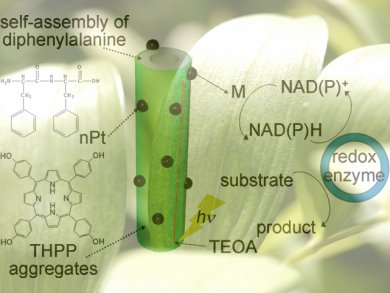Light-harvesting by natural photosynthesis occurs by means of two large protein complexes called photosystem I and II, which are composed of light-harvesting antenna, chlorophyll a and b, and catalytic metal clusters. Photoinduced electron transfer regenerates reducing power in the form of nicotinamide cofactors, NAD(P)H.
Chan Beum Park and colleagues, Korea Advanced Institute of Science and Technology, report peptide nanotubes synthesized by self-assembly of diphenylalanine, porphyrin, and platinum nanoparticles. The nanotubes can be used to regenerate NADH at much higher rates —1.78 h–1 — than inorganic nanomaterials such as CdTe (0.540 h–1) and CdSe (0.158 h–1) quantum dots, and p-doped TiO2 (0.003 h–1).
This integrated photocatalytic system is suitable for mimicking photosynthesis as it has a structure and electrochemical properties similar to photosystem I.
- Self-Assembled Light-Harvesting Peptide Nanotubes for Mimicking Natural Photosynthesis
J. H. Kim, M. Lee, J. S. Lee, C. B. Park
Angew. Chem. Int. Ed. 2011.
DOI: 10.1002/anie.201103244



